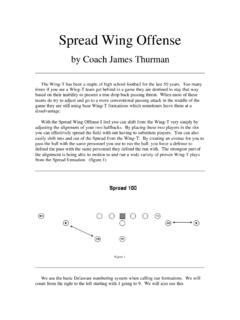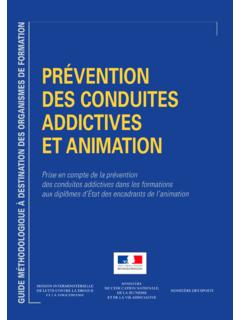Transcription of Introduction Calling Plays Offensive Numbering System ...
1 Introduction The Basics The Huddle Calling Plays Basic Alignments Offensive Numbering System Cadence and Snap Count Audibles and Dummy Audibles No-Huddle offense Personnel Groupings Hand Signals Formations Basic Backfield Sets Strong Side Formations Weak Side Formations Backfield Motions Halfback Alignments Fullback Alignments Tight End Alignments and Motion (Y). Flanker Alignments and Motion (Z). Split End Alignments and Motion (X). Formations (by Personnel Group). Shifting Defensive Recognition Fronts Coverage Pass Blocking Common Pass Routes Scramble Rules Plays Base Passes Action Passes Movement Passes Screens Nickel Passes Short Yardage Goal Line Red Zone Passes +20. +15. +10. +5. Base Runs Nickel Runs Short Yardage Runs Goal Line Runs Red Zone Four Minute No-Huddle/Audible Passes Hand Signals Runs Hand Signals Introduction Expectations As an Offensive unit, we expect the following from our coaches and players. 1. We will be precise in our execution of Plays . This will be derived from our attention to detail in everything we do as a team.
2 We will be efficient and machine like, regardless of the environment and the situation at hand. 2. We will be disciplined, and consider assignment errors and mental mistakes unacceptable. Turnovers will not be tolerated! 3. We will be a physically and mentally tough team. By structuring our practices as we do, you should not see anything in a game that you have not seen before in practice. No situation on the field should be unexpected. 4. We will play hard and with great effort on every play from the snap until the whistle blows. There is no reason to take Plays off! Definition Our offense is based upon Bill Walsh's 'West Coast Offense'. It is an offense that has been proven successful at the highest levels of football. With the proper commitment and attitude, it will be successful here too! The 'West Coast Offense' is not easy to define. But, two statements do help explain what it is all about. First, our offense uses "precision-timed passing, variable formations, and the exploitation of each player's skills" (quote by Bill Walsh) to attack the opposition.
3 We will feature a 'fully dimensional passing attack'. (including a short passing game that compliments the running game) and running game that controls the clock. We use multiple formations and personnel groupings to get favorable match-ups (ie. Flanker on a linebacker), run similar Plays from different looks, hide our key receivers, and let our quarterback see and read the defense. We want to force the defense to adjust and react to us, while at the same time taking what the defense gives us. Second, "The 'West Coast Offense' still amounts to nothing more than the total attention to detail and an appreciation for every facet of Offensive football and refinement of those things that are needed to provide an environment that allows people to perform at maximum levels of self-actualization" (quote by Bill Walsh). It is that attention to detail that will allow us to perform at our best and win football games. As important as the X's and O's are, it is our commitment to the entire System that will make us successful.
4 Principles of the West Coast Offense Protecting the Quarterback- We will protect the passer with a variety of protection schemes. Additionally, we will use the principle of a 'hot receiver'. This means that when the defense sends more rushers than we have blockers, one of our receivers will be available, allowing the quarterback to get rid of the ball before the rushers get to him. Timing Passes- Our routes have been set up so that the quarterback is able to deliver the ball right as the receiver is making his break. In other words, the depth of the receiver's route has been timed so as to correspond to the depth of the quarterback's drop. Use of Multiple Receivers- We will use as many as five eligible receivers on every pass play . Our routes will complement each other so that against man coverage there will be a 'clearing' action, and against zone defenders will have to choose who to cover, and who not to cover. Reading the Defense- It is important that both the quarterback and the receivers be able to read the coverage of the defense.
5 The quarterback needs to be able to choose the receiver he is going to throw the ball. The receivers need to be able to recognize the coverage, too, so that they can make necessary adjustment to their routes, or even run entirely different routes. Running and Passing Plays are Complimentary- Our offense is a System , with the running game and passing game complimenting each other. We will run and pass from all personnel groupings and formations. Runs will set up passes, and passes will set up runs. It is an entire System , and entire Offensive philosophy we intend to establish, not just a running or passing philosophy. Practicing the Fundamentals- We will practice, over and over again, the fundamentals of our offense. From the repeated practicing of the fundamentals and Plays , we will be able to execute our offense in a highly efficient manner. Passing Game Our passing offense will include several types of passes. Having several forms of passing in our scheme gives us a variety of Offensive weapons and enhances our ability to handle each contingency condition and situation as it occurs.
6 We will be unpredictable and force the defense to cover each eligible receiver. In addition to the types of passes, we will also group into " play groups." Each play group may have several different types of passes within it. Our passing attack will consist of six different types of passes. 1. Three-Step Drop- This type of pass is designed to be the ball control portion of the passing game. A. three-drop is the most appropriate play to use for "taking what the defense gives you.". The three most basic Plays that use the three-step drop combination are the quick out (Omaha), slant (Lion) and Hitch (Thunder). These pass Plays are most often utilized (though not always) as part of the audible process. 2. Five-Step Drop- This type of pass play forms the basis of our timing pattern package. Designed to be thrown before the defense has time to respond, the five-step drop pass can be throw utilizing three different footwork techniques: quick five-step drop, the big five-step drop, or the five-step drop with a hitch step.
7 Quick Five-Step Drop- The quarterback throws a pass off his fifth step, using a quick balance-throw action. Big Five-Step Drop- The quarterback takes three big drive steps, a throttle step to slow his drop, and a fifth step for balance. Five-Step Drop with Hitch Step- The quarterback takes a normal five-step drop, with one or two hitch steps. 3. Seven-Step Drop- A seven-step drop is designed to give the receiver time to maneuver before the ball is thrown. This technique gives maximum separation between the receiver and defenders, whether running a vertical route or one that crosses the field. Two other advantages to a seven step drop are the ability to incorporate layered routes into Plays and letting the receiver run "double-move". routes. 4. play Action Pass- "This type of pass is designed specifically to develop and take advantage of a defensive conflict. A fundamentally sound play that strives to contradict the basic principles of a defense, the play -pass gets the defensive team to commit to a 'fake' run and then throwing a pass behind the defenders off the fake.
8 " (Quote from Bill Walsh). The play action pass is particularly effective against defensive teams that are very active against the run. This type of pass exploits the intensity and aggressiveness of a defense. We will run our play action pass off of our most successful running Plays . There are several key elements to a successful play action pass play , in addition to being able to run the ball successfully. The play action pass must appear as close to the basic running play as possible. Line blocking, particularly at the point of attack, must simulate run blocking. There can be no easing up (by the linemen), as linebackers and defensive backs will be able to diagnose the play if any (letup) occurs. The running backs must run the same course they would if the were executing the running play , and they must hold their fakes through the LOS. The quarterback's mechanics must be the same as if executing the running play . His actions on both the pass and run should be consistent.
9 The design of each play will have a specific defender we want to attack. We will isolate which defender we will attack on each play action pass play . The faking back and quarterback must know which defender is being attacked. Their fakes are directed to fool that man, and there are differences between fooling a corner and a linebacker. 5. Action Pass- Action passes are designed to use the threat of the quarterback running the ball to allow him to get outside the "perimeter" of the defense. There are two ways for the quarterback to break contain and get outside defense: using a play action fake or simply moving the pocket. Either way, the key to action passes is to shorten the distance of the throw and create a throwing lane to the receiver outside the rush. 6. Screen Pass- This final type of pass play is designed to take advantage of a powerful pass rush. Screens are most effective when the offense is in an unfavorable down-and-distance. Often times in such situations, a defense will, in its quest to get to the quarterback, be susceptible to a screen pass.
10 In addition to the six types of pass Plays we employ, we will break our passing Plays into play groups, roughly corresponding to game situations. 1. Base Passes- Plays that can be used in nearly any down and situation, from any location on the field. These pass Plays are the core of our offense. 2. Action Passes- play action passes are pass Plays that are used in conjunction with our running Plays . 3. Movement Passes- Roll outs, sprint outs, and boot-legs make up the movement passes portion of our passing game. 4. Screens- A group of Plays consisting of various screen passes. 5. Nickel Passes- Pass Plays designed to be run in 'nickel' situations (ie. second and long, third and long, two minute offense, etc.). 6. Short Yardage- Pass Plays designed to be run in short yardage situations, such as second, third, or fourth and short. 7. Goal Line- Pass Plays that are designed to be run from inside the opponent's three-yard line. These Plays also may be used when attempting a two-point conversion.











